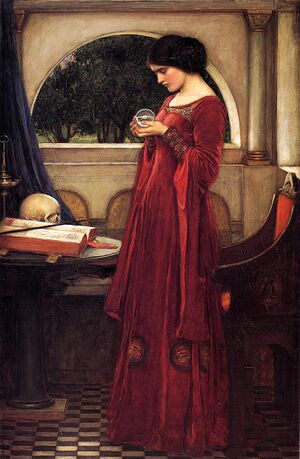Scrying (nonfiction): Difference between revisions
No edit summary |
|||
| Line 14: | Line 14: | ||
File:Thought camera.jpg|link=Scrying engine|[[Scrying engine]]. | File:Thought camera.jpg|link=Scrying engine|[[Scrying engine]]. | ||
File:Lanfranc-canterbury-mandelbrot.jpg|link=Canterbury scrying engine|[[Canterbury scrying engine]]. | File:Lanfranc-canterbury-mandelbrot.jpg|link=Canterbury scrying engine|[[Canterbury scrying engine]]. | ||
File:Hamangia-figures-Lorenz-attractor.jpg|link=Lorenz system (nonfiction)|Two [[Scrying engine|Hamangia figurine scrying engines]] computing the [[Lorenz system]] | File:Hamangia-figures-Lorenz-attractor.jpg|link=Lorenz system (nonfiction)|Two [[Scrying engine|Hamangia figurine scrying engines]] computing the [[Lorenz system (nonfiction)]]. | ||
</gallery> | </gallery> | ||
Revision as of 05:58, 13 June 2016
Scrying (also called seeing or peeping) is the practice of looking into a translucent ball or other material with the belief that things can be seen, such as spiritual visions, and less often for purposes of divination or fortune-telling.
Description
The most common media used are reflective, translucent, or luminescent substances such as crystals, stones, glass, mirrors, water, fire, or smoke.
Scrying has been used in many cultures in the belief that it can divine the past, present, or future.
The visions that come when one stares into the media are believed by some to come from one's subconscious and imagination, though others believe they come from gods, spirits, devils, or the psychic mind, depending on the culture and practice.
Fiction cross-reference
Two Hamangia figurine scrying engines computing the Lorenz system (nonfiction).



